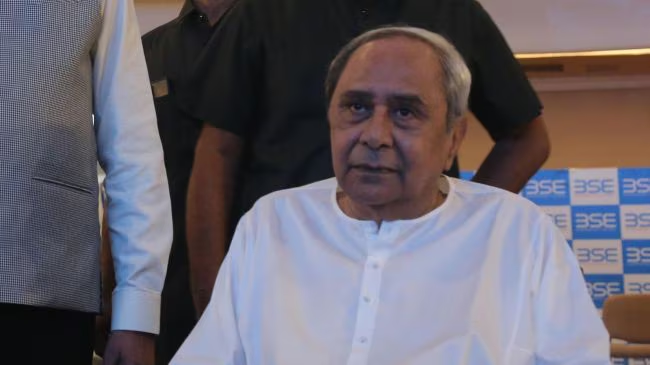Vice-President Poll Twist: BJD’s Abstention Becomes Silent Advantage for NDA’s Radhakrishnan

Image via The Indian Express
On Monday, September 8, 2025, the Biju Janata Dal (BJD) announced that it would abstain from voting in the Vice-President election. The election is set to take place on Tuesday, September 9. This sudden decision has created a new twist in the contest. Many observers say the step will indirectly help the NDA’s candidate C. P. Radhakrishnan.
Why Did BJD Decide to Abstain?
The announcement came after long discussions inside the party. Odisha’s former chief minister and BJD president Naveen Patnaik met senior leaders, members of the Political Affairs Committee, and Rajya Sabha MPs. The meeting focused on what stand the party should take in this important election.
In the end, Patnaik declared that the BJD will not vote for either side. Instead, it will stay away to keep an equal distance from both NDA and the INDIA bloc.
Party spokesperson and Rajya Sabha MP Sasmit Patra explained the decision. He said the main focus of BJD is the “development and welfare of 4.5 crore people of Odisha.” According to him, getting caught between two big alliances in Delhi is not the party’s priority.
Reports say that many senior leaders inside BJD wanted to vote against the NDA nominee. They feared backlash from the people if the party looked too close to the BJP. But supporting the opposition INDIA bloc also carried risks. Abstaining, therefore, looked like a safe middle path.
What Does Abstention Mean in Numbers?
The BJD has no members in the Lok Sabha after the 2024 general election. But it still has seven MPs in the Rajya Sabha. These seven votes could have carried symbolic weight. By not casting them, BJD has made the total number of valid votes smaller.
This means the winning quota will also come down. In a close contest, this helps the NDA’s nominee, C. P. Radhakrishnan. BJP leaders were quick to react. They said that abstention is “as good as indirect support.”
The Election Contest
The Vice-President election is being held because former Vice President Jagdeep Dhankhar resigned on July 21, 2025, citing health reasons. The election will happen in Parliament’s Room F-101, Vasudha, from 10 am to 5 pm on September 9.
There are two main candidates:
- C. P. Radhakrishnan, the NDA candidate. He is currently the Governor of Maharashtra, with additional charges of Telangana and Puducherry. He has been in public life for decades, starting as a BJP leader from Tamil Nadu.
- B. Sudershan Reddy, the INDIA bloc candidate. He is a former judge of the Supreme Court.
The voting will be done through a secret ballot. The system used is the Single Transferable Vote (STV) method. This means MPs rank the candidates in order of preference. To win, a candidate must secure more than half of the valid votes plus one. If no candidate crosses the mark in the first count, the least popular one is dropped, and their votes are transferred based on second preferences.
BJD’s Past Choices
This is not the first time the BJD has played a special role in Vice-President elections. In 2017, it supported NDA’s Venkaiah Naidu. In 2022, it supported Jagdeep Dhankhar, also an NDA nominee.
But the political situation is different now. After losing power in Odisha in 2024, the BJD has been trying to balance its national position. It no longer wants to be seen as too close to the BJP, but it also does not want to fully join the INDIA bloc. Abstention is a way to send a neutral signal while keeping options open for the future.
Other Regional Parties and Their Stands
Interestingly, the BJD is not alone in abstaining. The Bharat Rashtra Samithi (BRS), led by K. Chandrashekar Rao, has also decided not to vote. The BRS said its choice is a way of showing anger at both alliances over issues such as the farmers’ crisis and shortage of fertilizers.
On the other hand, the YSR Congress Party (YSRCP) has openly declared support for the NDA’s candidate. With such shifting positions, the final numbers in the election may look very different from what many expected earlier.
Why This Matters Nationally
The role of regional parties in national elections has always been important. Even a small number of votes can make a difference in contests where margins are thin. The BJD’s seven abstentions reduce the INDIA bloc’s chances of closing the gap.
At the same time, this decision also helps BJD internally. If the party had voted for the NDA, it could have faced anger from sections of its supporters who already accuse it of being “too close” to the BJP. If it had voted for the INDIA bloc, it would have risked losing goodwill with the Centre. By staying out, BJD can argue that it acted in the best interests of Odisha.
Looking Ahead
The stage is now set for the big vote on September 9. Political experts say that while the NDA was already seen as having an advantage, the abstention by BJD and BRS has given its candidate an extra edge.
For the INDIA bloc, the challenge is now greater. They will have to depend heavily on their allies and hope that no more regional parties decide to stay away.
Regardless of who wins, the BJD’s decision has once again shown how regional parties can shape national outcomes. Their choices may look small in numbers, but in reality, they can tilt the balance in elections that define India’s highest offices.